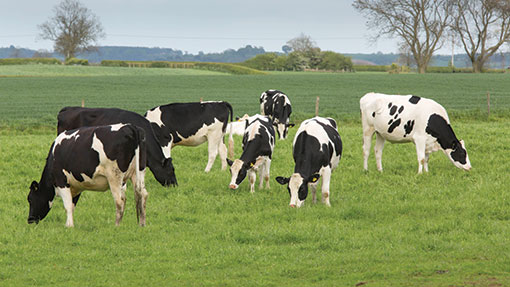Tackle underweight dairy heifers this autumn

Dairy farmers still have time to correct heifer growth rates if these have not been met at grass this summer, in order to reach the 24-month-old first-calving goal.
Concerns were raised by HST Feeds after research showed replacement heifers at grass were not meeting required weight gains.
A weighing of 150 Holstein heifers in the North West, which were out at grass with no supplements, showed they had been growing at an average of 0.43kg/day during the past two months – well below the recommended target of 0.85kg/ day.
See also: Chase efficiencies, not yields, for dairy profit
Instead, daily liveweight gain across the sample ranged from 0.08-0.82kg/day from June to August.
Youngstock expert Rachael Kennerley from HST Feeds says the information confirms that even when heifers are grazed on quality pastures, grazed grass alone is not sufficient and heifers require supplementary feeding to meet their growth targets.
“When we also consider that we are now later into the grazing season and both grass quality and quantity are likely to reduce, supplementary feeding becomes even more vital,” she adds.
Cost of delayed calving
An autumn-born heifer calving at two years old costs about £1,530, based on 0.82kg of daily liveweight gain (DLWG). Whereas an autumn-born heifer calving at two-and-a-half years growing at 0.7kg DLWG, would cost an extra £320*. *Calculations are based on rotational grazing for two summers without concentrate and being housed for two winters with silage and concentrate.
Causes
Tom Bell, senior technical specialist at Kingshay, believes poor growth rates usually stem from a late spring turnout and set stocking youngstock on grass that has already got away in the belief there will be more feed in front of them.
“Heifers turned out in spring on to grass covers that are too high (3,500-4,000kg/ha DM) will look great to start with, but after three months or so without attention, the grass will be trodden and will start to head, with little new grass coming through.
“What is left is mature, high-fibre grass that’s low in sugars, protein and metabolisable energy. There may still be large quantities, so they get their dry matter intake, but the quality has gone and use is on the floor,” he says.
Advice
Mr Bell says farmers should graze their heifers in a similar way to the dairy cow, and believes unless there is a decent paddock or rotational grazing system, heifers will suffer.
First, he advises calculating necessary growth rates before target AI date, so heifers achieve the desired weight at service. Farmers should then calculate a diet to provide the cheapest means of providing the compensatory growth.
“Take a fresh grass sample and formulate the diet with nutritionist guidance based on the results. This may be based on third-cut silage aftermaths, with or without concentrates, or housing early on a high-density diet.”
It is important to prioritise remaining quality grazing and third-cut silage aftermaths for underperforming stock, adds Mr Bell.
He says underperforming stock can be identified by weighing regularly – ideally monthly – to allow time to adjust the diet if growth rates are not on target.
Heifers should be grouped according to their weight, not size, as this will ensure the group can be monitored closely, explains Mr Bell.
